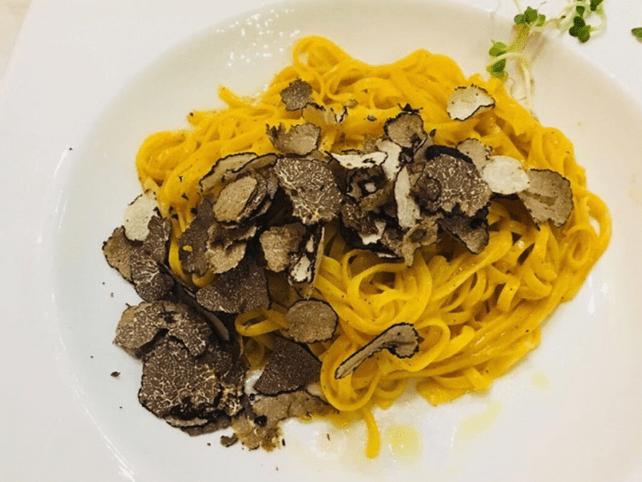6.12.2023
Drinking a glass of San Vito di Luzzi Wine is your personal jump into an ancient tradition, that of a nectar prized by the ancient Romans, and in less remote times by the Cistercian Monks, who settled in the small village of San Vito di Luzzi, in the north of Cosenza, the famous Monastery of Sambucina.
The presence of the monastery gave a further boost to the production of wine at Luzzi, and now this authentic piece of Calabrian and Mediterranean gastronomy is important, in defining the identity of our cuisine, just like local bergamot, salami, dairy, honey, fruit and all other flavors of the territory.
LOCATION
Nowadays, San Vito di Luzzi is a sub-region of the protected area of Terre di Cosenza DOC. It was once a DOC in its own right, but was subsumed into the Terre di Cosenza in 2011, along with its neighbors Donnici, Pollino and Verbicaro.
In well-exposed vineyards, located in the village of San Vito in the municipality of Luzzi, in the province of Cosenza, the homonymous wine is produced in the following types: red, white and “rosato”.
Given that it is named after San Vito village (in the parish of Luzzi), located in the hills of Calabria’s northwestern coastline, this wine is mainly made in the village of Luzzi. This small town situated on the lower slopes of the Sila National Park is the only one authorized, according to the Regulations, to produce this wine, which must come from local vineyards.
However, for the production of the red, white and rosé wines, many non-native varieties are used; for example, some of them come from the Sangiovese vine.
The territory is that in front of the Tyrrhenian Sea and under the large Sila Plateau. These areas are vital factors in creating the agriculturally suited microclimate here. Precisely, the volume of waters surrounding the Calabrian peninsula is a vital component of the local terroir, helping to moderate the intense heat of the south Italian summer.
The mountainous topography around Luzzi helps to channel air up and down the valleys, providing a more stable environment in which to grow healthy vines.
HISTORY
After an oblivion of 2000 years, this wine now has a well-deserved but discreet renown. The San Vito di Luzzi D.O.C. was established in 1994, combining the area’s ancient winemaking traditions with qualities that can be appreciated by the modern consumer.
Even if it is produced in the tiny municipality of Luzzi in the province of Cosenza, this remote area of Calabria has an ancient history. The ancient Romans prized the wine, while after some centuries the Cistercian Monks settled here and built the famous Monastery of Sambucina, which increased and improved the production of wine at Luzzi.
One of the most fascinating aspects of the remote winemaking is the magical combination of geological and climatic conditions with the work of Monks.
This explains why you can find an unbelievable combination of fragrances and perfumes in the wine of such a tiny territory, giving rise to a superior-quality wine.
FEATURES
San Vito di Luzzi was introduced as a DOC title in October 1994, a year before Verbicaro just to the north. Both wines were granted DOC status almost 20 years after the other DOCs in northwestern Calabria, making them the relative newcomers to the Calabrian quality wine scene. However, they did not gain any traction as a distinctive wine appellations, and as a result, both were absorbed as sub-regions of the Terre di Cosenza DOC introduced in 2011.
The grapes used to make Terre di Cosenza San Vito di Luzzi wines are typically Calabrian vine varieties. The most commonly used of these is Gaglioppo, but Malvasia Nera, Greco Nero and Sangiovese are also used. The local white wines are based on Malvasia Bianca and Greco Bianco.
The San Vito di Luzzi Doc wine generally has a minimum alcohol content, ranging from 10.5 degrees to 11.5 degrees for either the white or the red.
The typical red has an intense, dry flavor and a velvety red color. The rosé has a mild aroma and flavor, although it is dry, cool and elegant with a minimum alcohol content of 11 degrees. The white has a yellowish color with a more or less intense flavor and pleasant aroma.
Speaking more precisely of “San Vito di Luzzi Rosso” (red), it comes from Gaglioppo grapes (70% minimum), Malvasia grapes and any other red-berry vines, including Greco nero and Sangiovese; it has a more or less intense ruby red color, is pleasant and delicate, has a characteristic smell, and has dry and velvety flavors. The minimum alcohol content is 11.5°, perfect for every meal.
With regard to “San Vito di Luzzi Bianco” (white), its grapes are white Malvasia and Greco, with the possible addition of other white grapes (maximum 40%). The wine, coming from such a blend, has a more or less intense straw color, a pleasant smell, and dry, harmonious and delicate flavors.
The minimum alcohol content is 10.5°; its typical use is as an appetizer.
“San Vito di Luzzi Rosato” (rosè) is made with the same grapes of the red Gaglioppo (minimum 70%), of Malvasia and of any other red-berry vines, among which the Greco Nero and the Sangiovese. It has a more or less intense pink color, sometimes with orange hues, is delicate, has a characteristic smell, and has fresh, dry, harmonious, elegant flavors. The minimum alcohol content is 11 °C, perfect for every dinner.

SMAF LTD
Explore our products, coming from CALABRIA. Order the food and beverage products that allow you to explore the Mediterranean diet of a remarkable region. Surrounded by two seas and adorned with pine forests, mysterious villages, natural habitats, and rich biodiversity. Discover handcrafted delicacies that embody the soul of the land: sun-ripened fruits, premium olive oils, bold wines, artisanal cheeses, and traditional cured meats, all crafted with passion and authenticity.





